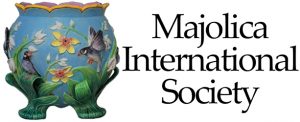Table Centers
By the middle of the nineteenth century, dining had become something of a ritual and the Victorian dinner party was the premier social event. The affair followed exacting contemporary rules of etiquette and was designed so as to impress one’s guests and raise the host’s standing in the community.
The ardor for formal entertainment led to an abundance of majolica tablewares in a fashionably furnished home. Majolica plates and serving pieces passed the table with each dinner course. Their effect on the seated guests, however impressive, was fleeting. In contrast, the dining room table centerpiece remained in place throughout the dinner service. As such, table centers were of a scale and level of grandeur to be sufficiently imposing and leave a lasting impression on those in attendance.
Majolica table centers were produced in a wide variety of shapes and styles. A large center bowl was often formed from a shell, basket or pierced container supported by putti, classical mythological figures or animals. The centerpiece was often displayed at the table overflowing with fruit. In some examples, smaller shell forms surrounding the base were intended to hold sweetmeats.
Photo Credits:
Strawser Auctions
Live Auctioneers
Ebay images
Madelena Antiques
Antiques from Trilogy
Philppe Meunier & Juan-Alonso Defrocourt
Karmason Library













